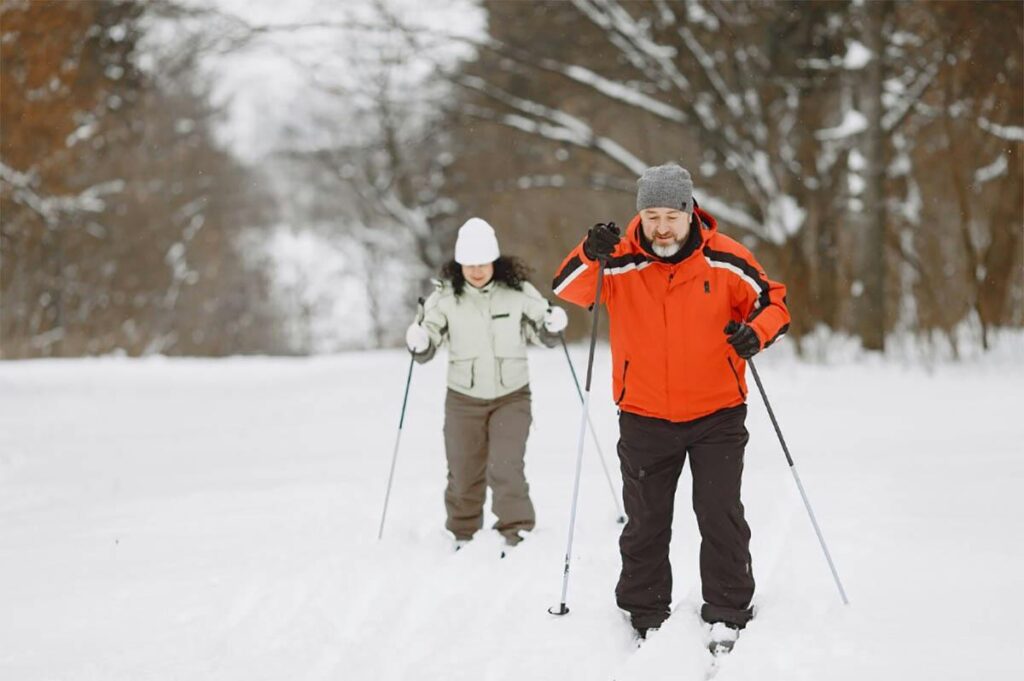Introduction
Skiing transcends being a mere sport; it’s a thrilling global adventure that captivates enthusiasts worldwide. To fully savor this experience, arming yourself with essential skiing tips is paramount. Let’s dive into crucial insights, including how to avoid skiing injuries ensuring exhilaration and safety on the slopes.
Preparing for a Safe Ski Trip
Skiing and snowboarding contribute to approximately 600,000 sports-related injuries annually. Embarking on a skiing adventure is thrilling, but a safe and enjoyable experience requires thorough preparation. This goes beyond gear inspection; it involves a comprehensive approach covering equipment and physical readiness.
Gear Check
Minimize the risk of injury by routinely checking and maintaining skis, bindings, poles, and boots. Consult professionals if needed. Layer up for warmth and equip yourself with waterproof gloves, goggles, and a helmet to enhance safety and prevent skiing accidents on the slopes.
Physical Readiness
Maintaining a condition suitable for skiing can significantly reduce the risk of knee injuries. Strengthen your legs, core, and cardiovascular fitness through targeted exercises. Prioritize flexibility with stretches for the quadriceps, hamstrings, and hip flexors. Warm up with gentle aerobic exercises and stretches to prepare muscles for skiing.
On the Slopes: Safety Practices

Once on the slopes, prioritizing safety is crucial, and adapting to diverse skiing conditions requires common sense. Whether navigating freshly fallen powder or icy slopes, adjusting techniques according to conditions is essential for a secure and enjoyable skiing experience.
Let’s discuss skiing safety tips for handling various terrains and weather situations, ensuring a safe and enjoyable skiing experience.
Powder Skiing Techniques: Learn effective strategies for navigating through freshly fallen powder, including the benefits of private lessons. Enhance your skiing experience by optimizing enjoyment while minimizing the potential for accidents on the slopes.
Icy Slope Safety: Discover essential tips and techniques for skiing on icy slopes, emphasizing control and stability in challenging snow conditions.
Techniques for Varied Terrains: Explore adaptable skiing techniques suitable for different terrains, catering to varying snow conditions and your skill level, from groomed trails to off-piste adventures.
Weather Considerations: Understand the impact of cold weather on skiing conditions and learn how to adjust your approach based on the prevailing elements, ensuring a safe and enjoyable experience on marked trails.
Skiing in Different Terrains
Skiing goes beyond traditional slopes to diverse terrains like backcountry, groomed trails, and terrain parks. Each offers a unique, thrilling experience.
Learn to adjust techniques, maximize enjoyment, and embrace challenges in every landscape.
Embracing Variety
Explore a range of terrains in skiing, each with its own allure. From untouched backcountry snow to meticulously groomed resort trails, this diversity enriches your skiing adventure.
Adjusting Techniques
Tailor your skiing techniques to each terrain’s characteristics. Understanding these adjustments enhances control and enjoyment when navigating powder-filled backcountry or executing precise turns on groomed trails.
Post-Ski Recovery
The enjoyment doesn’t conclude when you remove your skis; it extends into the crucial phase of post-ski recovery.
This section delves into why recovery is vital for overall well-being and highlights the significant impact of incorporating physical therapy techniques.
Importance of Recovery
Following an exhilarating day on the slopes, prioritizing post-ski recovery is crucial. It goes beyond routine as a fundamental element in safeguarding physical health, preventing fatigue, and avoiding injuries. Dedicating time to recuperate revitalizes your body and ensures you return to the slopes with renewed vigor.
Incorporating Physical Therapy Techniques
Explore how integrating physical therapy techniques into your post-ski recovery routine can make a substantial difference. From targeted exercises that alleviate muscle soreness to practices enhancing flexibility, these techniques contribute to your recovery and long-term well-being.
When to Seek a Physical Therapist

Recognizing signs of potential injuries is crucial. Knowing when to consult with a physical therapist can not only prevent further damage but also aid in a quicker recovery.
If you experience any of these signs, it is advisable to consult with a healthcare professional promptly for a thorough assessment and appropriate guidance:
- Be vigilant if you experience ongoing pain and discomfort or find your movement restricted after skiing.
- Pay attention to any unusual swelling or bruising that persists beyond the immediate post-skiing period.
- Notice any alterations in your range of motion, as challenges in moving joints may signal an underlying concern.
- Take note of persistent fatigue or weakness that extends beyond normal post-skiing tiredness.
Early intervention reduces complications, ensuring a safer, more enjoyable skiing experience. Include the ski jump exercise to enhance physical readiness. Learn preventive measures, like how to prevent ACL injuries, for overall skiing safety. For specialized backcountry physical therapy, explore our services and prioritize your well-being. Book a session today for a healthier, safer skiing journey!
Conclusion
In conclusion, skiing is a sport that combines excitement and responsibility. By following these skiing tips, including proper care of your ski equipment and adhering to safety rules, you can ensure a safe and enjoyable experience on the ski slopes. Embrace the thrill of skiing while prioritizing your well-being.
FAQs
Q1: Is skiing safe for beginners?
A1: Absolutely! With the right guidance, proper gear, and adherence to safety practices, skiing can be a safe and enjoyable activity for beginners. Skiing is a demanding sport, and maintaining good physical condition can aid in injury prevention. Ensure you’re physically ready before hitting the slopes.
Q2: How can physical therapy help in skiing injury recovery?
A2: Physical therapy can aid recovery by providing targeted exercises to strengthen injured muscles, improve flexibility, and enhance overall recovery.
Q3: How can I improve my skiing technique?
A3: Improving your skiing technique involves practice, professional guidance, and a willingness to adapt. Consider taking lessons and continuously refining your skills to become a more proficient skier.



